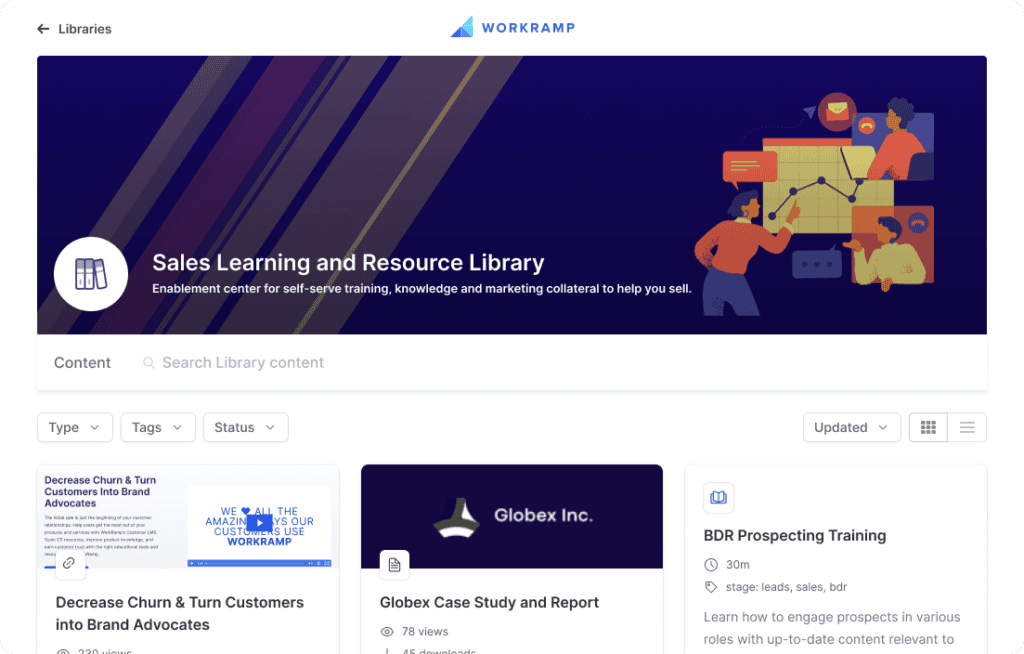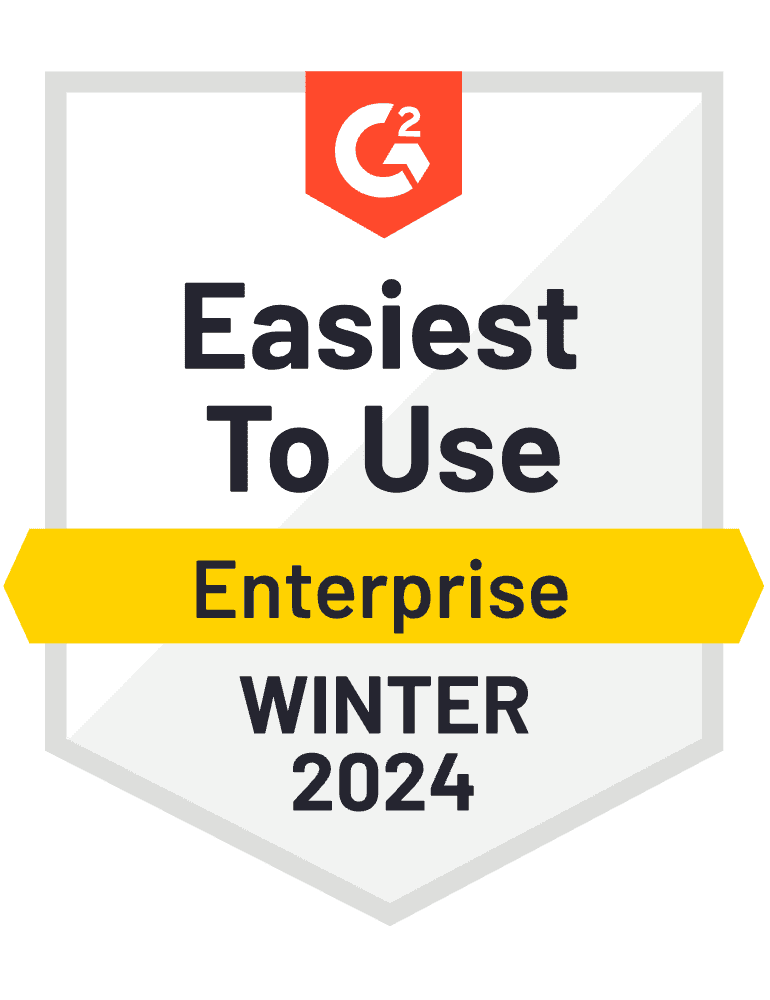What is Sales Enablement? Tools, Strategies, & Best Practices
Anna Spooner | WorkRamp Contributor
View bioLearning Tips Straight to Your Inbox
Sales enablement is the strategic, ongoing effort that provides sellers with the content, resources, sales training, and sales coaching they need to engage buyers effectively.
Sales enablement is a fast-growing priority. The 2023 State of Sales Enablement report found that 90 percent of respondents have a sales enablement solution at their organization, a 15 percent increase from last year.
Investing in an enablement function can be a true differentiator in today’s competitive market. Companies with effective sales enablement can expect better win rates, higher quota attainment, and increased employee and customer retention.
The 2023 report found that a dedicated sales enablement program increases win rates by 9 points.
If you want to improve your bottom line, you can’t afford to miss out. Discover the importance of sales enablement and the essential components for an effective sales enablement program.
In this post:
What is sales enablement?
Sales enablement is the support given to the sales team to effectively and efficiently move buyers through the buying process, increase close rates, and improve sales and revenue.
Enablement programs can also support other customer-facing teams, such as customer service and customer success, to help retain new customers and reduce churn.
A sales enablement team is essentially an ongoing change management team, so it’s vital to have support from top leadership and excellent communication and listening skills. This helps create buy-in with sales reps so that go-to-market strategies are successful.
Sales enablement example
One example of sales enablement is helping sales reps access the right materials at the right time.
Without a sales content management system (CMS), that can be very difficult. That’s why nine out of 10 B2B sellers don’t use sales enablement content—they are outdated, too hard to find, or too hard to customize to the lead.

Pictured: WorkRamp CMS
With WorkRamp’s LMS + CMS, you can create a centralized location for all of your revenue enablement learning and content. The platform is searchable, so sales reps can discover and share what they need right away. It’s also easy to update materials as things change.
With WorkRamp’s LMS+ CMS, you can train sales teams quickly, create sales and demo certifications to improve engagement and performance, and track training results with advanced reporting and custom dashboards.
Why is sales enablement important?
Sales enablement is essential because it drives results. At a glance, the 2023 State of Sales Enablement report shows that sales enablement efforts can significantly improve:
-
-
- Win rates
- Quota attainment
- Customer retention
- Employee engagement
-
Additionally, sales enablement teams help improve your sales rep onboarding process. Organizations with a strong onboarding process can lower ramp time by two months. How would it benefit your organization if ramp time was two months shorter?
Read more: 3 Sales Rep Ramp-Up Strategies to Get Productive Faster
Sales enablement is a key part of aligning marketing and sales teams. Misalignment between sales and marketing costs businesses $1 trillion a year in wasted efforts and low productivity, but aligning these functions can increase closed deals by 67 percent.
“Without an enablement team, you’re flying a team and building it at the same time,” according to Nina Bankar, Vice President of Customer Success at Calm. “This can result in a couple of crash landings. An enablement team can help guide what needs to happen to ensure customers are successful. Without enablement, you’re setting yourself up for more pain and potential failures.”
Sales enablement benefits
Why are 90 percent of organizations using sales enablement? There are a host of benefits that help both the company and sales reps.
Here are a few of the top benefits of sales enablement.
Streamlined training and ramp time
Sales enablement allows training to be optimized to focus more specifically on the customer journey and address each rep’s strengths and weaknesses.
When your organization implements sales enablement, training is an ongoing process, not a one-time, annual, or semi-annual event.
As a result, sales reps stay up-to-date with new processes, retain the information they learn in training more easily, and improve their results throughout the year.
Sales enablement also makes new hire training more intentional and up-to-date, resulting in shorter ramp times and faster quota attainment.
Aligns sales and marketing teams
As mentioned above, sales and marketing misalignment costs organizations significant money every year. With a sales enablement team, the information sharing between sales and marketing is efficient, and neither department is siloed.
This means sales and marketing work together more effectively, saving the organization money and dramatically improving bottom-line results and team morale.
Creates a single source of truth
What’s the proper way to handle a lead with a specific objection or to move forward with LinkedIn prospecting? Without a sales enablement team, a new sales rep may get a dozen different answers to those questions.
A sales enablement function creates a single source of truth for sales processes and training, which can reduce confusion, curb bad habits, and decrease the number of mistakes propagating across the department.
Shorter sales cycles
When your sales reps are well-trained in everything from product knowledge to handling objections and have easy access to sales materials when needed, they’ll be far more effective. As a result, sales cycles will be shorter, and revenue will be higher.
Sales enablement tools
Sales enablement tools can overcome pain points and help the team be more successful and efficient. Software like sales intelligence software, a content management system, a sales CRM, a knowledge base, and an all-in-one learning platform can significantly affect the sales enablement team’s performance.
Learning management systems
A learning management system is a software platform that makes it easy to create engaging sales enablement training and deploy it in multiple ways. For example, with the Learning Cloud from WorkRamp, you can offer microlearning, on-demand courses, hybrid learning, and in-person training.
Having the right learning management system is essential to a successful sales enablement program.
Customer relationship management
Both sales reps and managers need to know where a deal is in the sales process. A strong customer relationship management (CRM) tool will give the sales team visibility into the number of leads, how they’re moving through the customer journey, and how long it’s taking.
The information from the CRM helps the sales enablement team align sales expectations with the customer journey, streamline the sales process, and more. This is a key part of sales enablement—setting your sales reps up to succeed.
Content management system
As mentioned earlier, reps won’t use sales materials if they can’t find them easily, trust that they’re accurate, and customize them to fit the potential customer. A CMS solves those problems.
WorkRamp CMS allows you to centralize marketing materials, update them regularly, and give sales reps a place to find GTM materials quickly and easily. This will not only reduce unnecessary overlap in marketing efforts, but it will also ensure the materials you create are used by reps.
Sales enablement platforms
There are also sales enablement-specific platforms that try to provide everything you need to maximize the efficiency of the sales process, train sales reps effectively, and improve the sales team’s overall performance.
WorkRamp’s LMS + CMS allows you to manage GTM materials and create sales training while also providing the opportunity to develop excellent employee development programs.
Sales enablement strategies and best practices
Whether you’re just building your sales enablement program or you’ve had one for a few years, it’s helpful to know the top strategies and best practices.
1. Prioritize sales and marketing alignment
Unfortunately, in many organizations, sales and marketing are siloed. One of the top focuses of the sales enablement team is to act as a liaison between marketing and sales and help them understand each other and work together.
Improving sales and marketing alignment dramatically increases win rates, shortens sales cycles, and saves the organization time and money.
2. Know your sales enablement goals
By tracking how successfully sales reps meet their goals, enablement can pinpoint ways to offer or improve training, optimize the sales process, create necessary content, and more. The enablement team is also often in charge of helping managers become capable coaches for their sales reps, which helps everyone improve.
How can you focus your sales enablement team on specific goals when they have many organizational roles? Consider these five focus areas for your sales enablement strategy.
3. Focus on the buyer-seller relationship
A strong relationship between the buyer and the sales rep helps accelerate deals and improve win rates. The biggest factor in this relationship is trust.
How can you build trust between leads and the sales team? By having reps well-educated on the product or service and the customer journey. When the reps have confidence and understand exactly where the lead is—and thus what information they need to move forward—the relationships with the buyers will be strong.
“As a sales professional, being able to be in the shoes of your prospect or customer is invaluable,” says Marit Parten, Sales Enablement Manager, Level Access. “It’s absolutely invaluable to follow that customer journey and identify where we can truly help.”
4. Build your sales enablement team
Sales enablement allows you to coordinate the efforts of everyone in your organization that helps the sales team succeed: marketing, operations, product management, L&D, and more.
Having a sales enablement team with a specific charter, clear responsibilities, accountability, and goals is the best practice for improving your sales results. This strategy can help you increase win rates, quota attainment, customer retention, and revenue. At the same time, it allows you to reduce ramp time and get more productivity and engagement from your sales team.
5. Offer sales enablement training
Training is essential in improving sales reps’ results, whether new hires or seasoned reps. The ability to package training into microlearning or on-demand courses and measure results allows the sales enablement team to track rep growth and correlate those improvements with training.
When Reddit implemented sales training with the Learning Cloud, they were able to reduce sales ramp time by 33 percent, and existing employees scored over 90 percent on a brand pitch challenge. Effective training makes a big difference in performance!
6. Ensure content is accessible and relevant
Sales enablement content includes internal assets that help sales reps be more effective. The enablement team creates and organizes content that sales reps use to educate their prospects, address concerns, answer questions, and make the sale.
Common sales enablement content includes:
- Buyer personas
- Email templates
- Talk tracks
- Discovery call checklists
- Demo recordings
- Case studies
- One-pagers
- ROI calculators
The 2023 Sales Enablement report found that organizations that know what content engages leads are 38 percent less likely to struggle with sales velocity.
7. Measure sales enablement impact
The sales enablement team impacts sales results in two ways: first, they train sales reps and improve performance, and second, they refine the sales process to better match the buyer journey.
Both of these impacts can be measured. By using the reporting features in an LMS like the Learning Cloud, the sales enablement team can show that training programs are effective and make a concrete difference in the bottom line.
Tracking metrics like sales velocity, win rates, deal size, and overall revenue allows you to measure the impact of making the sales process more effective and efficient. As a result, it’s easy to show the positive difference a sales enablement team makes in the organization.
Read more: 15 Sales Enablement Metrics to Measure in 2024
More about sales enablement
Still have questions about sales enablement and what it can do for your company?
Here are the answers you are looking for.
What is the difference between sales enablement and marketing?
Sales enablement serves as a strategic and tactical liaison between the sales and marketing teams.
Generally, the marketing team builds brand awareness for your products or services, creating leads. The sales reps follow up with leads and make the sale. Marketing might also focus on creating materials that the sales reps use to generate and propel leads and interact with prospects along the buying journey.
Sales enablement ensures that the processes, changes, and materials coming from marketing are translated into a language and motion that the sellers understand and can easily use daily. Sometimes, the enablement team will “deliver” the marketing assets or deliverables to sales in a consumable and relevant format.
Mark Hart, Chief Operating Officer at Pollen Returns, a pick-up service for e-commerce businesses, notes in a recent Martech article, “A typical salesperson says, ‘just buy it, whatever it is.’ Marketing will say ‘buy what is promoted.’ Operations and inventory will say, ‘just buy what is there.’ What each unit sees as a “win” is different.”
Russ Sharer, Chief Sales Officer for The Brooks Group, says, “It is actually a big deal in most companies that the incentives for the three groups often are contradictory. Combined forecasting meetings should bring the three together, where they must show their work and defend their plans.”
Aligning the goals and expectations of each department is one of the key functions of the sales enablement team. When everyone is on the same page, the sales process matches the customer journey, and sales reps have excellent leads and high-quality, customizable marketing materials to win the sale.
Many organizations also have a content marketing team. This unit creates content for buyers and prospective buyers, like blog posts, white papers, eBooks, and more. The sales enablement team focuses on creating internal content that sales reps use to understand the product and connect with prospective buyers.
Sales enablement is often confused not just with marketing but with sales operations as well. Understanding the difference between sales enablement and operations helps keep your enablement team focused on the areas where they can have the most impact.
Who owns sales enablement?
Sales enablement works best when there’s a dedicated team with a formal charter and responsibilities.
A dedicated team allows the enablement team to focus solely on training, sales process improvements, onboarding, sales assets, and coaching initiatives to improve sales performance. Ideally, the sales enablement team should report to a revenue leader like the Chief Revenue Officer.
What is the role of a sales enablement specialist?
One of the reasons it’s helpful to have multiple people on the sales enablement team is because the team has so many responsibilities. It’s great to have an individual or team focused on creating training, reviewing the alignment between the buyer journey and sale process, measurement and metrics, and leading the charge on sales coaching.
In other words, there’s no single role in sales enablement—there are multiple elements involved in setting sales up for success.
What are the pillars or focuses of sales enablement?
The pillars of sales enablement are generally training new hires and seasoned sales reps, optimizing the sales process, and aligning marketing and sales so that sales materials are effective, up-to-date, well-organized, and easy to use.
Within these focus areas are a wide range of tasks, and it’s also important to measure the results of initiatives to ensure they have a positive impact on sales results. However, if a sales enablement team can do those three things, the organization will have dramatically better win rates, employee retention, quota attainment, and bottom-line revenue.
Optimize your sales enablement training program
A sales enablement team can help to improve results at every level. Teams work together better, your company saves money lost due to inefficiency, and you increase win rates and quota attainment. You can’t afford not to have a sales enablement team.
Great sales enablement teams are even more effective with the right tools and resources. The Learning Cloud can help you equip your sales team with on-demand training to increase rep efficiency, drive revenue and performance, and close more deals.
Help your reps perform their best with the Learning Cloud. Contact us for a free, personalized demo.
Complete the form for a custom demo.
Recent Posts
- WorkRamp Launches AI Practice to Revolutionize Sales Enablement July 22, 2024
- How to Recognize Employee Burnout July 17, 2024
- What is the Best SCORM-compliant LMS? July 10, 2024
- How to Make a Training Module For Online Learning (2024 Guide) July 1, 2024
- The Role of Emotional Intelligence in Sales Enablement June 28, 2024
Anna Spooner
WorkRamp ContributorAnna Spooner is a digital strategist and marketer with over 11 years of experience. She writes content for various industries, including SaaS, medical and personal insurance, healthcare, education, marketing, and business. She enjoys the process of putting words around a company’s vision and is an expert at making complex ideas approachable and encouraging an audience to take action.
You might also like
Why you need sales enablement content as part of your sales strategy
The right sales enablement content empowers your team to answer questions, address objections, concerns, and pain points, and convert prospects into customers.
Read More
3 essential sales enablement tools
Too many tools can be distracting for reps. Here are the enablement tools you really need to achieve sales goals.
Read More
Build an effective sales enablement strategy with these tips
Sales enablement is critical to provide tools, technology, and content to help your sales reps. Make sure your enablement strategy includes these elements.
Read More
Ready to Explore Online Learning Platforms?
Get in touch to learn how WorkRamp can help you achieve your training goals.
Request a Demo



